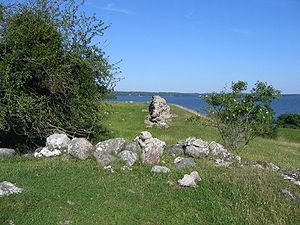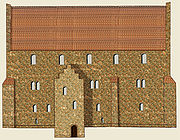
Alsnö hus
Encyclopedia

Hovgården
Hovgården is an archaeological site on the Lake Mälaren island of Adelsö in Ekerö Municipality in central-eastern Sweden. During the Viking Age, the centre of the prospering Mälaren Valley was the settlement Birka, founded in the mid-8th century and abandoned in the late 10th century and located...
settlement. It is located on Adelsö
Adelsö
Adelsö is an island in the middle of Lake Mälaren in Sweden, near southern and northern Björkfjärden. The administrative center of the important Viking settlement Birka was situated at Hovgården on Adelsö.-Geography:...
island, in Lake Mälaren
Mälaren
Lake Mälaren is the third-largest lake in Sweden, after Lakes Vänern and Vättern. Its area is 1,140 km² and its greatest depth is 64 m. Mälaren spans 120 kilometers from east to west...
in central-eastern Sweden
Sweden
Sweden , officially the Kingdom of Sweden , is a Nordic country on the Scandinavian Peninsula in Northern Europe. Sweden borders with Norway and Finland and is connected to Denmark by a bridge-tunnel across the Öresund....
. As part of Hovgården, it is declared a World Heritage Site
World Heritage Site
A UNESCO World Heritage Site is a place that is listed by the UNESCO as of special cultural or physical significance...
.
History
Next to the ruin is five burial moundMound
A mound is a general term for an artificial heaped pile of earth, gravel, sand, rocks, or debris. The most common use is in reference to natural earthen formation such as hills and mountains, particularly if they appear artificial. The term may also be applied to any rounded area of topographically...
s — the largest with a diameter of 45 metre — dating back to the Vendel Era
Vendel era
In Swedish prehistory, the Vendel era is the name given to a part of the Germanic Iron Age ....
(i.e. Late Iron Age
Germanic Iron Age
The Germanic Iron Age is the name given to the period 400–800 in Northern Europe and it is part of the continental Age of Migrations.-Germanic Iron :...
, c. 500-800 CE) when Hovgården was a so called King's House (Kungsgård). The royal castle Alsnö hus reflects the importance of Birka
Birka
During the Viking Age, Birka , on the island of Björkö in Sweden, was an important trading center which handled goods from Scandinavia as well as Central and Eastern Europe and the Orient. Björkö is located in Lake Mälaren, 30 kilometers west of contemporary Stockholm, in the municipality of Ekerö...
, the trade settlement on Björkö
Björkö
Björkö can signify:# In Sweden:## Björkö, a Lake Mälaren island in Ekerö Municipality, Stockholm County, the location for the excavation and World Heritage Site Birka....
island just south of Adelsö. However, Birka was abandoned around 975, but apparently the royal mansion continued to be of importance as the runestone U 11 (c. 1070 CE) was erected next to it.

Magnus III of Sweden
Magnus III Ladulås of Sweden, Swedish: Magnus Birgersson or Magnus Ladulås was King of Sweden from 1275 until his death in 1290....
had the old fortress replaced by a summer residence built in brick. In contrast to the many fortifications built during the era, this building was a summer residence more adapted to offer comfort than defence and it regularly served both Magnus and his son Birger during summers. The Ordinance of Alsnö
Ordinance of Alsnö
The Ordinance of Alsnö is an act by king Magnus Ladulås of Sweden, probably produced in Alsnö hus in September 1280, giving exemption from land taxation to those nobles who committed to produce a heavy cavalryman to the king's service. This established the frälse, the tax-exempt secular nobility...
(Alsnö stadga) was made here in 1279, often said to be the foundation of the Swedish nobility
Swedish nobility
The Swedish nobility were historically a legally and/or socially privileged class in Sweden, part of the so-called frälse . Today, the nobility is still very much a part of Swedish society but they do not maintain many of their former privileges...
as a separate social class and the start the Swedish feudal system. Large parts of the Romanesque
Romanesque architecture
Romanesque architecture is an architectural style of Medieval Europe characterised by semi-circular arches. There is no consensus for the beginning date of the Romanesque architecture, with proposals ranging from the 6th to the 10th century. It developed in the 12th century into the Gothic style,...
parish church Adelsö Church
Adelsö Church
Adelsö Church is a church located on the Lake Mälaren island Adelsö, in Ekerö Municipality in central eastern Sweden.The Romanesque church, itself founded in the 12th century, is located next to Hovgården, an excavation site and a World Heritage Site dating back to before the Viking Age Adelsö...
next to the present ruins date from this period and was possibly commissioned by the king.
The building was ruined by the end of the 14th century, and little remains today. When the ruins were excavated in 1916-18, a huge number of crossbow
Crossbow
A crossbow is a weapon consisting of a bow mounted on a stock that shoots projectiles, often called bolts or quarrels. The medieval crossbow was called by many names, most of which derived from the word ballista, a torsion engine resembling a crossbow in appearance.Historically, crossbows played a...
arrows were found, indicating the palace might have been burnt down by the pirates of Albert von Mecklenburg
Albert of Sweden
Albert was King of Sweden from 1364 to 1389 and Duke of Mecklenburg-Schwerin from 1384 to 1412.-Background:...
who raided the Baltic
Baltic Sea
The Baltic Sea is a brackish mediterranean sea located in Northern Europe, from 53°N to 66°N latitude and from 20°E to 26°E longitude. It is bounded by the Scandinavian Peninsula, the mainland of Europe, and the Danish islands. It drains into the Kattegat by way of the Øresund, the Great Belt and...
in an attempt to reclaim the Swedish crown to Albert.
The ruins were bought by the Royal Swedish Academy of Letters, History and Antiquities
Royal Swedish Academy of Letters, History and Antiquities
The Royal Swedish Academy of Letters, History and Antiquities also called simply the Royal Academy of Letters, abbreviated KVHAA is the Swedish royal academy for the Humanities.Its many publications include the archaeological and art historical journal Fornvännen, published since 1906.The Academy...
(Vitterhetsakademien) in the 1950s and 1960s and is today preserved by the Swedish National Heritage Board (Riksantikvarieämbetet).

